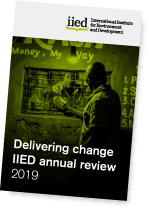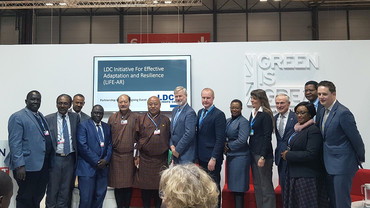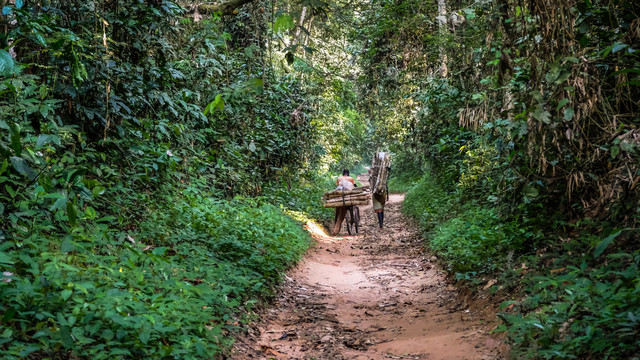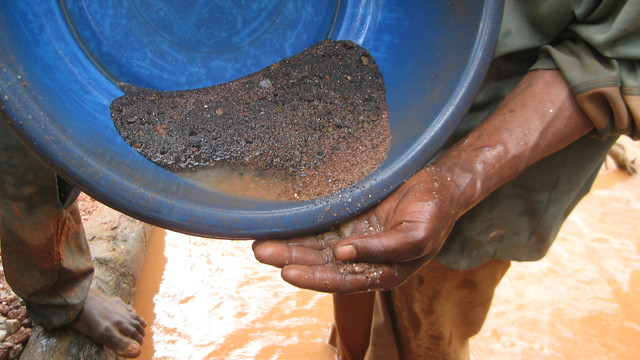
A rural kiosk that uses a low-cost solar power system, Kisumu, Kenya (Photo: copyright Sven Torfinn/Panos Pictures)
– Andrew NortonThis collection of stories shows how, with the right approaches, IIED and partners are making a positive difference to those on the frontline of complex and interlinking global crises.
CONFRONTING THE ECOLOGICAL AND SOCIAL EMERGENCY
The facts are indisputable. Our ecological and social systems are in deep, unprecedented crisis.
Climate disasters causing death, disease, displacement and widespread economic damage are occurring at an estimated rate of one a week.
In the world’s towns and cities, these climatic shocks combine with rapid growth to deepen risks to citizens, hitting the poorest and most vulnerable the hardest. Unsustainable production and consumption patterns are speeding mass extinction, wildlife population decline and the collapse of vital ecosystems with grave impacts for our societies, our economies and our food systems. Vast inequality, driven by growing levels of elite wealth, undermines the global solidarity needed to create a future where both people and nature can survive and thrive.
Last year we launched our strategy identifying where we can make the biggest difference in addressing five of the world’s most pressing challenges, listed here. The stories in this annual review show how we are delivering our ambition.
Read our 2019-24 strategy: Make Change Happen
A full PDF version of our 2019 annual review is available.

THE CLIMATE CRISIS
Global climate action remains wholly inadequate to meet the scale of the challenge. We responded by collaborating with progressive voices to drive rapid change, and we trained women climate negotiators from developing countries to reflect national ambition at the highest levels. With climate finance still failing to reach those experiencing the harshest realities of the climate crisis, we advanced our ‘money where it matters’ work – providing a model for shifting funds to community level.
Bold vision challenges world to reset climate response
The climate change narrative has long been skewed towards mitigating emissions; adapting to the impacts has come in a distant second. But 2019 saw adaptation climb the political agenda – and we seized the moment to take practical, locally tested solutions from the climate frontline to the forefront of global policy.
We accelerated our support to the world’s least developed countries (LDCs) as they continued to champion the needs and priorities of people who have contributed least to the climate crisis but are suffering the most.
The LDC Initiative for Effective Adaptation and Resilience (LIFE-AR) calls for a radical new approach to climate action – away from short-term thinking to long-term planning.
Together, we built a rich evidence base of locally driven and durable adaptation interventions. This underpinned the LDC 2050 Vision – a bold, ambitious plan for achieving climate-resilient development, allowing LDC societies, economies and ecosystems to thrive.

Fires being used to clear land in Indonesia are destroying tropical forests and peatlands and causing significant greenhouse gas pollution, with health impacts for local people (Photo: CIFOR, via Flickr, CC BY-NC-ND 2.0)
Working with the LDCs and wider partners, we deepened the evidence during our annual flagship community-based adaptation event. The ‘talanoa’ open dialogue session – talanoa being a Pacific word that describes story-based problem solving – was a highlight, where a largely Southern community of adaptation practitioners, researchers, grassroots representatives and local government planners shared first-hand experience of adaptation initiatives that work.
LDC chief negotiator Tenzin Wangmo and Sheela Patel of Slum Dwellers International and the Global Commission on Adaptation (GCA) chaired the session. As with LIFE-AR, we are working with the GCA to steer greater attention to locally led adaptation action; moving the emphasis from planning and coordination to tangible delivery, where clear mechanisms are in place to ensure that women and men living in poverty, young and old, able or differently abled, get the support they need to respond to climate shocks and stresses.
On the international stage at September’s UN Climate Action Summit we supported the LDCs to land their message with force. As nations gathered to showcase their commitments to tackling climate change, the LDCs took their place as leaders, standing united behind their vision and coming forward with commitments for enhanced nationally determined contributions – five-yearly plans for how countries will achieve their climate targets – and national adaptation plans. Ireland stepped forward in support, pledging €1 million to LIFE-AR with Austria, Bhutan, Burkina Faso, Denmark, Ethiopia, Finland, Germany, Italy, Malawi, Sweden, the Gambia, the United Kingdom and Uganda joining the endorsement.
In another major success this year, the Asian Development Bank (ADB) responded to calls from the LDCs and wider social movements for a shift away from the business-as-usual climate response. Under the Community Resilience Partnership Program, ADB, social coalitions such as the Huairou Commission of women leaders and think tanks including IIED, will work with governments to help countries in Asia and the Pacific develop ways to scale up investment in local priorities to tackle poverty, climate and disaster coherently.
Now the focus is 2020: the first moment for accountability following the 2015 Paris Agreement, when countries will be asked to step up action to bring climate change under control. In this make-or-break year for global climate policy, IIED and partners are ready to push hard for a locally informed, and locally led, response to the climate emergency.

INCREASING URBAN RISK
With steep urban growth comes risk, especially for those on low incomes, migrants and refugees. This year, we worked with partners at community level in East Africa, seeking solutions to evolving shelter needs. New work on air pollution will complement our 2019 analysis of health threats to urban workers.
Q&A: Unlocking safe shelter for Mogadishu’s most vulnerable
Having a place to call home, to gather, to cook, to rest and feel safe are the most basic of human needs. IIED and partner research, supported by the East African Research Fund, is examining the systems governing access to shelter in three of Africa’s fastest growing cities – Hawassa in Ethiopia, Mogadishu in Somalia and Nairobi in Kenya. Erik Bryld, from our partner Tana, describes the challenges facing groups on the sharp end of Mogadishu’s shelter squeeze and the policy shifts needed to help these groups find a safe place to live.

There are more than 2m internally displaced people in Somalia, fleeing from conflict and natural disasters. In Mogadishu, most refugees live in Buuls - temporary shelters made from sticks, plastic and fabric (Photo: copyright Tana Copenhagen)
Q: Why is demand for shelter in Mogadishu so acute?
Mogadishu is urbanising faster than any other African city and the pressure on informal settlements is intense. Push and pull factors add to the pressure: drought drives rural populations to the city in search of work while vast numbers continue to flee Somalia’s decades-long conflict. At the same time, the city’s thriving economy offers migrants a huge casual labour market.
Q: What factors determine access to safe and affordable shelter?
Most people who move to Mogadishu find shelter in some form or another. The question is, how secure is that shelter? Kinship and clan identity play a major role here: the better connected you are, the more likely you will find a place that is secure and affordable. On the flipside, people from minority groups are exposed to less secure shelter at higher costs. And money, of course, is a dominating factor – wealth opens most doors.
Q: Which groups struggle most to find secure shelter?
Our research has highlighted three vulnerable groups. Women in Somalia are susceptible to gender-based violence and other kinds of exploitation. Single, widowed or divorced women are particularly at risk and finding shelter that offers enough security is a major challenge. Single young men are labelled as troublemakers and often suspected of being connected to al-Shabaab. Sitting at the bottom of the social hierarchy, they are regularly denied shelter access. Poor infrastructure in settlements cannot cater for people living with disabilities. This group is vulnerable and isolated.
Q: Based on this research, what policy interventions will help these groups find safe shelter?
Our research shows between half and two thirds of migrants want to reside in Mogadishu permanently. So we need to move away from short-term humanitarian responses – supplying settlements with food, water and latrines – and recognise this is an urban development issue needing a longer-term approach. Ultimately, land control and ownership drive the fierce competition for shelter; effective land governance systems are needed before tenure security can be addressed. But in the short- to medium-term, we need to focus on livelihood opportunities for the most vulnerable groups.
This touches on many aspects, such as enabling access to banks and credit; providing public transport between settlements and the city; making settlements more secure for single women entrepreneurs; and improving school access so that parents – mothers in particular – can find work outside the settlement.
Q: How will the findings from the research help to make that shift?
We’re working on two levels. The international donor community informs the relief programmes delivered by United Nations agencies and international NGOs so we’re working to raise donor awareness that we need durable, rather than simply technical, solutions to the shelter challenge. Through a series of policy briefings, we’re highlighting the challenges that poor, displaced and vulnerable groups face in accessing shelter, and convening development practitioners to discuss recommendations.
At the local level we’re working closely with the mayor’s office – the Benadir Regional Administration (BRA) – to develop settlement management guidelines. These provide a framework to support access to safe shelter and services, and we’ve been advocating for the voices of these groups to be included in the drafting process.
We’ve also connected BRA officials with Slum Dwellers International (SDI). This network has a deep-rooted history of supporting locally informed housing solutions, co-produced between government and informal settlement residents in Nairobi. SDI’s knowledge and experience of getting ground-level realities recognised in policy would be invaluable as we go deeper into exploring the barriers to shelter for Mogadishu’s most vulnerable.

UNSUSTAINABLE MARKETS
Inequitable markets undermine efforts to preserve biodiversity, reduce poverty and combat climate change. In 2019 we worked at multiple levels to support green transitions, from supporting small, sustainable businesses to grow and thrive, to working with the World Benchmarking Alliance on measuring how well business goals align with the SDGs.
Community forest businesses take off in Congo Basin
Community forestry products such as timber and foraged or crafted items are usually sold locally and vulnerable to fluctuating demand and the vagaries of weak forest governance. But since 2016, a consortium of local and international organisations – the CoNGOs project – has worked in Cameroon, Central African Republic (CAR), Gabon, Republic of Congo and the Democratic Republic of Congo (DRC) to support producers and civil society reach far wider markets and improve local access and control over forest resources.
Alongside local partners, IIED led on in-country investment and training, covering community forestry management, organisational development, policy advocacy, marketing and more.
By 2019, project results were remarkable.

Forestry worker, Cameroon (Photo: copyright: Alfredo D’Amato/Panos Pictures)
In DRC, 16 enterprises grew their incomes by 50-900%, thanks to new technology, diversification and greater productivity. Ten artisanal logging businesses doubled their efficiency and production capacity. In Cameroon, bush mango producers accessed foreign buyers; prices rose by 150%.
In CAR, where forest producers’ land rights were not even recognised, the first-ever official community forest was allocated. Three communities now manage 15,000 hectares and have the stability necessary to make long-term plans and start or grow businesses.
Local people know how to harvest forest goods sustainably but need backing to reach the next level. The many locally controlled enterprises are now skilled up, able to access better markets and set to keep growing. And with increased economic clout, they are well placed to influence policies affecting community forest land and livelihoods.

AN ASSAULT ON THE NATURAL WORLD
Environmental justice will elude us as long as the people closest to local land- or seascapes are overlooked. We made the case for linking biodiversity and development more strongly than ever in 2019. We also forged links between Chinese and African policymakers, seeking benefits and protections for communities and ecosystems targeted by colossal development.
Making the link between biodiversity and development, loudly
IIED has long argued that biodiversity is a critical resource for the world’s poorest people, for food, livelihoods and climate resilience. Strong ecosystems on land and at sea underpin nature-based solutions to core development challenges.
In 2019, we took our call for greater collaboration between the biodiversity and development sectors to its widest audience yet.
In April, we published 'Biodiversity loss is a development issue: a rapid review of the evidence'. Within six months, this issue paper had been downloaded over 2,370 times; a related blog was viewed over 1,800 times. We also contributed an article on the topic to respected journal 'The Lancet Planetary Health'.

Biodiversity is a critical resource for the world's poorest people (Photo: WaterFrame/Alamy Stock Photo)
In May, a landmark UN report warned of the need to safeguard biodiversity. A statement from IIED director Andrew Norton, highlighting the crisis and the role for development, received extensive media coverage, including the BBC, Channel 4 News and Reuters.
Our thinking also helped underpin the new cross-party People and Nature campaign calling on the UK government to make all its aid nature-positive.
We will keep engaging effectively with policymakers and development organisations, arguing for the post-2020 biodiversity framework to include development issues such as social justice, human rights and poverty alleviation, and for the international development agenda to recognise the critical role of biodiversity.

Related blog: Biodiversity loss – more than an environmental emergency
The development community has a blind spot for biodiversity and its connection to social issues, says IIED’s Dilys Roe in an opinion piece.

INCREASING INEQUALITY
In a polarised world, inclusion and justice are touchstones across our work. This year, we amplified voices for fairer representation: preparing negotiators from developing nations to argue for a fairer share of ocean resources and supporting African women to be heard on land governance issues. We also pursued our ambition of sustainable energy access for all.
Troubled waters spell deep problems for people too
In 2019, public concern for the ocean’s health spiralled. Harrowing images of plastic-choked turtles went viral. Shocking reports exposed how expanses of water are left poisoned and barren after absorbing carbon emissions and from overfishing. Leading scientists made the bleakest ever predictions of marine species extinction.
As one interconnected body of water, reckless abuses of the ocean can cripple coastal communities far from the original source. But government pledges of greater action to protect and restore the ocean are mostly silent about the people whose livelihoods rely on our seas.
This year, our policy interventions and action research forced a more people-centric approach into the ocean governance debate. Building on long experience of supporting the least developed countries (LDCs) in global climate talks, we provided legal, technical and strategic advice to these and other countries taking part in negotiations for a new international treaty that seeks to govern the high seas.
These vast reaches of the ocean belong to us all and should benefit everyone. But with greater economic and technological strength, it is chiefly richer nations that exploit the high seas. Coastal communities in developing countries – where millions depend on the ocean for jobs, income and nutrition – are left behind.

Bangladesh fishermen bringing their boats ashore. Small-scale fishing and related businesses provide livelihoods for millions of people (Photo: copyright Espen Rasmussen/Panos Pictures)
Our support armed the LDCs to negotiate for a fairer and more inclusive agreement that will enable vulnerable coastal economies to build resilience and thrive, and groundbreaking research showed that ocean connectivity means abuses can damage communities thousands of miles away. The approach brought concrete results: the latest draft of the negotiating text was updated to recognise that the treaty must protect the many millions of people who depend on the high seas.
We explored how to embed our people-centric approach into policy and practice by holding multi-stakeholder dialogues, expert workshops and high-profile think dinners in Dhaka, London, Nairobi, New York, San Jose and Yangon. International and national policymakers, diplomats, ocean experts, fisheries associations, civil society and small-scale fishers discussed ways to protect marine resources that ensure people do not slip through the net.
And we made strides in our efforts to gain recognition for the millions of people working in small-scale fishing. The industry provides over half of the fish consumed globally and provides jobs and income for millions. Yet these small, informal businesses are often not visible beyond the local level and their contribution to national economies goes largely unrecorded. As a result, they receive minimal attention from policymakers and minimal investment.
We worked with government officials from ten countries on how to capture information such as how many women and men the sector employs, or how much fish they catch and process. Costa Rica has begun implementing systems to determine the value of the small-scale fishing sector to the national economy, and we’re working with Cambodia to better capture fishing data to inform policies that are fairer and more inclusive.

Related collection: Inclusive blue economy
Supporting resilient marine and coastal ecosystems and the millions of people who depend on them to thrive by aligning incentives with investments.
Working in partnership with others
Collaboration is at the heart of everything we do. Working together, we ask challenging questions and develop practical solutions to make change happen. The highlights in this 2019 review show how we have worked in partnerships across the world to find solutions to complex and evolving global challenges.
IIED’s five-year strategy renews our commitment to working together to achieve lasting policy change for a more sustainable world.
Download the annual review

Our full 2019 annual review, 'Delivering change', presents some of our strongest achievements over the last year
Sign up for our email
Our email newsletters deliver up-to-date information about our latest work on critical issues
Responsible operations
We have a clear plan to reduce our carbon emissions and environmental impacts, and work responsibly
Our funding
We are committed to financial transparency: our website provides up-to-date, detailed financial information







